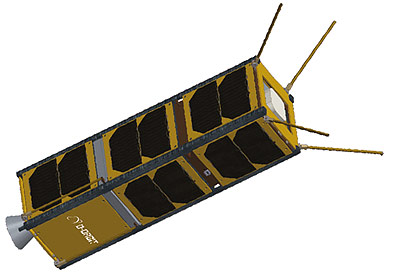Thank you very much for visiting Gunter's Space Page. I hope that this site is useful and informative for you.
If you appreciate the information provided on this site, please consider supporting my work by making a simple and secure donation via PayPal. Please help to run the website and keep everything free of charge. Thank you very much.
D-Sat

D-Sat [D-Orbit]
The D-Sat (Deorbit Satellite) is a 3U CubeSat mission by Italian company D-Orbit to demonstrate active end-of-life reentry.
The satellite carries D-Orbit Decommissioning Device (D3), a device with three key characteristics. First of all, it needed to be compact and lightweight, easy to integrate it inside existing satellite platforms during design and manufacturing. Second, it had to be able to execute a quick and direct re-entry maneuver at the end of the satellite’s mission. Finally, it had to be independent from the main spacecraft’s systems, so it would work even in case of major malfunction of the hosting satellite. It is a smart propulsive system that can be scaled to easily fit any size spacecraft. Its compact solid rocket motor is designed to execute a single high-trust burn to quickly remove a spacecraft form orbit. Its independent control unit and communication system ensures that the system can be activated and controlled from the ground even if the spacecraft has ceased operations.
Besides the de-orbiting device, D-Sat carries three more experiments:
- SatAlert, designed in collaboration with CNIT and the University of Florence, is an in-orbit validation of the Multiple Alert Message Encapsulation (MAMES) emergency protocol. D-Sat will collect MAMES emergency messages sent from a ground station, store them onboard, and re-broadcast them to national public safety entities upon receiving a trigger command. This experiment will validate a typical emergency scenario where civil defense agencies need a means to broadcast instructions in areas affected by natural disasters when the ground telecommunication infrastructures have been damaged
- DeCas, developed in by Aviosonic, is an experiment to assess the dynamics of the debris footprint associated to the re-entry of a spacecraft. DeCas is a sort of small and lightweight “smart fragment” with the ability to determine its own position during re-entry phase. During the re-entry, DeCas activate itself and broadcast information about its location. In a real-world scenario, this information would be processed on the ground to determine the debris footprint, which would then be transmitted in real-time to airplanes flying over that zone and populated areas below. D-Sat will validate this approach by simulating the use of DeCas during the orbital phase, and performing an actual test during re-entry.
- Atmosphere Analyzer is a data collection experiment aimed at collecting in-situ atmospheric data from the lower ionosphere during the re-entry maneuver. Before breaking up, D-Sat will cross the region between 80 km and 150 km. This is the least studied region of the atmosphere because it can’t be reached by satellites or stratospheric balloons. By doing so, D-SAT will validate an innovative approach for an in-situ data collection system that will be further developed in a dedicated mission in 2019.
The satellite was launched on 23 June 2017 as a secondary payload on an Indian PSLV-XL rocket.
On 2 October 2017, the deorbit motor was fired, but instead of deorbiting, a misalignment of the motor with the satellite center of gravity caused a tumble during the motor's burn and the orbit was raised to 506 km × 686 km, 97.6°.
| Nation: | Italy |
|---|---|
| Type / Application: | Technology |
| Operator: | D-Orbit |
| Contractors: | D-Orbit, GOMSpace |
| Equipment: | D3, SatAlert, DeCAS, atmosphere analyzer |
| Configuration: | CubeSat (3U) |
| Propulsion: | compact solid rocket motor |
| Power: | Solar cells, batteries |
| Lifetime: | |
| Mass: | 4.5 kg |
| Orbit: | 497 km × 516 km, 97.45° |
| Satellite | COSPAR | Date | LS | Launch Vehicle | Remarks | |
|---|---|---|---|---|---|---|
| D-Sat | 2017-036AF | 23.06.2017 | Sr FLP | PSLV-XL | with Cartosat 2E, NIUSAT, CE-SAT 1, Max Valier Sat, Venta 1, CICERO 6, Lemur-2 34, ..., 41, Blue Diamond, Green Diamond, Red Diamond, COMPASS 2, InflateSail, LituanicaSAT 2, URSA MAIOR, NUDTSat, Pegasus, UCLSat, VZLUsat 1, PACSCISAT, Aalto 1, ROBUSTA 1B, SUCHAI, skCUBE, IDEA |
References:
- D-Orbit: D-SAT mission
- D-Orbit: D-SAT Mission brochure
